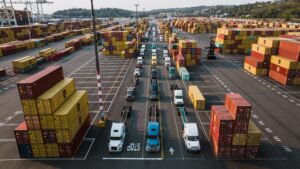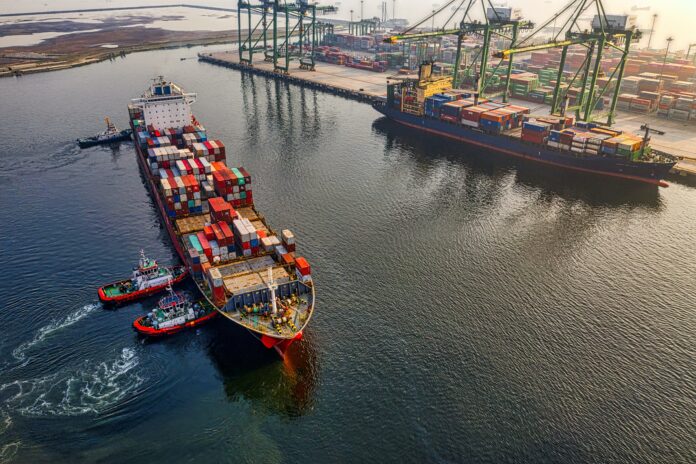What is Logistics?
The term ‘logistics’ was first originated in the military, where they used this term to refer to the movement of equipment and supplies to military troops in the field. In the business world, the term implies a process of transporting, supplying, moving or shipping of goods from one place to another i.e., from the point of origin to the point of destination. Logistics is one of the aspects of Supply Chain Management System that includes storing and delivering of finished goods and services to customer within a specified time and at a competitive price.
To provide ease of doing business, after 8 years of consistent efforts, National Logistics Policy (NLP) finally came into effect on 17th September, 2022. It was formulated by the Commerce and Industry Ministry and officially launched and addressed by our Prime Minister, Narendra Modi in Vigyan Bhawan, Delhi to enhance India’s trading industry. The goal of the Prime Minister is to create a standard world-class modern infrastructure by including all relevant stakeholders in the process of holistic planning and implementation. The policy aims to bring down the cost of logistics by 5 per cent of GDP over the next 5 years and make logistics industry more efficient.
 Logistics have been the backbone of India’s International Trade that aids in diversification of country’s exports and imports all over the world. The policy strategy to promote the seamless movement of goods and commodities across the country and make the Indian product more competitive in the domestic market as well as in International market, thus leads to increase in competitiveness all over the globe.
Logistics have been the backbone of India’s International Trade that aids in diversification of country’s exports and imports all over the world. The policy strategy to promote the seamless movement of goods and commodities across the country and make the Indian product more competitive in the domestic market as well as in International market, thus leads to increase in competitiveness all over the globe.
National Logistic Policy (NLP) is a comprehensive effort which aims to boost the economic growth by addressing cost and inefficiency issues, thus lying down an overarching interdisciplinary, cross-sectoral, and multi-jurisdictional framework for developing entire logistics ecosystem. The policy seeks to reduce the losses incurred during transportation of perishable commodities by improving the warehouse and supply chain efficiency.
Objectives of National Logistics Policy
- Minimize Manufacturing Costs.

- Efficient Flow of Operations.
- Better Communication Flow.
- Provides Competitive Edge.
- Better Inventory Management.
- Logistics Management Solution.
Features of National Logistics Policy
- The policy seeks to promote blockchain and AI adoption in the country and organize the mega-market, thus providing a standard structure to Indian logistics.
- The program aims at lowering the logistics costs from 15% of India’s GDP to 8% in 5 years. It will promote exports and domestic product efficiency.
- The government aims to be among the top 25 countries in the Logistics Performance Index (LPI) by 2030.
- The NLP will include the Unified Logistics Interface Platform (ULIP). It would unite transportation-related online services into a single unified platform.
- Every Indian state needs a Logistics Coordination Committee. Each state’s performance will be evaluated annually using the LEADS index. Central government will provide a template for improving logistical efficiency, allowing states to build their own systems.
- This sector includes 20 major and 40 subordinate government agencies. 50 IT centers, banks, insurance firms, 37 export promotion committees, 200 shipping companies, 36 logistics services, 129 inland container depots, 168 container freight terminals.
- The new logistics policy will also assist the country’s logistics sector in becoming an integrated, cost-efficient, resilient, and sustainable logistics ecosystem, covering all bases, streamlining rules, and addressing supply-side constraints.
- National Organic e-Market will be developed for organic products. Financing of negotiable warehousing receipts would be encouraged and also its integration with e-NAM.
Benefits of National Logistics Policy
- Reduced logistics costs boost efficiency across several industries, supporting wealth creation, encouraging value addition and entrepreneurship.
- Provides employment opportunities to millions of people.

- The policy would benefit country’s farmers by allowing them to take their produce to the markets even faster as it reduces waste and delay. Krishi trains shall also be run on PPP mode.
- Quick deliveries will be made through improved and unified transportation and online communication system, ending transport-related issues, saving manufacturers and exporter’s time and money.
- Coordination improvements will boost sector speed, value creation, and entrepreneurship.
- Ease of Logistics Services will allow companies to immediately contact government agencies with questions and complaints.
- The improvement in the logistics sector is expected to facilitate 10% decrease in indirect logistics cost, which may lead to the growth of 5 to 8% in exports.
- Integration at the central level between various ministries and agencies will be enhanced. Considered as the lifeline of National economy, National Logistics Policy and GatiShakti are expected to work as double engines for logistics.









